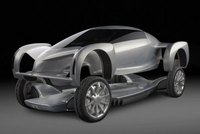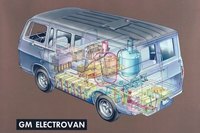GM Heritage Center Shares History of Hydrogen Fuel Cells
Pioneering Vehicles Sent to Petersen Automotive Museum in Los Angeles
Sterling Heights, Michigan – When the world’s first fuel cell-powered vehicle was transported from the General Motors Heritage Center near Detroit to the Petersen Automotive Museum in Los Angeles, it did not make the trip alone. GM’s pioneering 1966 Electrovan was accompanied by the paradigm-changing AUTOnomy fuel cell concept car that captured the world’s attention when introduced by GM at the 2002 North American International Auto Show.
“These two vehicles, separated by nearly 40 years, serve as very relevant examples of the never ending reinvention of the automobile that drives GM engineers and scientists” said Scot Keller, staff director of GM Corporate Brand Communications. “Hydrogen provides a source of power that promises to remove the automobile from the environmental equation. Over the decades GM has dedicated significant resources to unlocking its potential”.
The Petersen Museum exhibit, “Propulsion after Petroleum” is designed to highlight the work that the automobile industry has done over the years to become less dependent on fossil fuels for efficiency, environmental and economic reasons. The exhibit, which opened April 22, is scheduled to run through September 10, 2006.
The Electrovan, successfully built and tested by GM researchers 40 years ago, demonstrated the feasibility of a propulsion system using electrical power developed by cyrogenically stored hydrogen and oxygen combined with potassium hydroxide. There were no batteries to charge and no petroleum fuel to burn.
In 2002, GM’s AUTOnomy concept vehicle took hydrogen fuel cell technology into the future with a design that combined fuel cell technology with a by-wire control system. The resulting skateboard-like chassis capitalized on an extremely compact fuel cell stack to create a platform that has the potential to revolutionize the way cars can be designed and built.
Today, GM hydrogen fuel cell-powered vehicles are in test fleets on three continents, actively demonstrating the company’s ongoing commitment to the reinvention of the automobile.
The Electrovan and AUTOnomy are just two of the more than 700 vehicles currently found in the GM Heritage Collection of historically significant vehicles that date back to the early 1900s.




